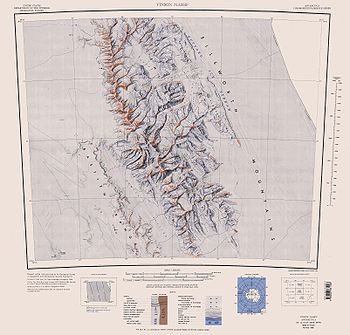
Mount Craddock
Encyclopedia

Mountain
Image:Himalaya_annotated.jpg|thumb|right|The Himalayan mountain range with Mount Everestrect 58 14 160 49 Chomo Lonzorect 200 28 335 52 Makalurect 378 24 566 45 Mount Everestrect 188 581 920 656 Tibetan Plateaurect 250 406 340 427 Rong River...
forming the south extremity of Craddock Massif
Craddock Massif
Craddock Massif is a mountain massif in the Sentinel Range of the Ellsworth Mountains, in the Chilean claim of West Antarctica.-Location and highest point:...
in Sentinel Range
Sentinel Range
The Sentinel Range is a major mountain range situated northward of Minnesota Glacier and forming the northern half of the Ellsworth Mountains in Antarctica. The range trends NNW-SSE for about and is 24 to 48 km wide...
, the highest mountain in Antarctica. It is linked by Karnare Col
Karnare Col
Karnare Col is the narrow rocky col of elevation 2100 m linking the southeast slopes of Mount Craddock to the northeast ridge of Mount Strybing in southern Sentinel Range, Ellsworth Mountains in Antarctica. It is extending 1.7 km in east-west direction, with a depression in its eastern part...
to Mount Strybing
Mount Strybing
Mount Strybing is a mountain standing 3 nautical miles southeast of Mount Craddock in the south part of Sentinel Range, Ellsworth Mountains. It is linked to Mount Craddock by Karnare Col. First mapped by United States Geological Survey from surveys and U.S. Navy air photos, 1957-59. Named by...
in the southern Sentinel Range. The ninth highest mountain in Antarctica was first climbed in January 1992.
The name Mount Craddock was originally recommended by US-ACAN
Advisory Committee on Antarctic Names
The Advisory Committee on Antarctic Names is an advisory committee of the United States Board on Geographic Names responsible for recommending names for features in Antarctica...
in 1965 for the present-day Craddock Massif
Craddock Massif
Craddock Massif is a mountain massif in the Sentinel Range of the Ellsworth Mountains, in the Chilean claim of West Antarctica.-Location and highest point:...
but subsequent maps limited Mount Craddock to the massif’s southernmost peak, a position that became established over years. To avoid confusion and to fix the position of the name, US-ACAN redefined Mount Craddock in 2006 to apply to the southernmost peak described above.
The mountain was named by US-ACAN for J. Campbell Craddock (1930–2006), leader of a University of Minnesota
University of Minnesota
The University of Minnesota, Twin Cities is a public research university located in Minneapolis and St. Paul, Minnesota, United States. It is the oldest and largest part of the University of Minnesota system and has the fourth-largest main campus student body in the United States, with 52,557...
expedition (1962–63) that made geological investigations and cartographic surveys in the Sentinel and Heritage Range
Heritage Range
The Heritage Range is a major mountain range, long and wide, situated southward of Minnesota Glacier and forming the southern half of the Ellsworth Mountains in Antarctica...
s of the Ellsworth Mountains
Ellsworth Mountains
The Ellsworth Mountains are the highest mountain ranges in Antarctica, forming a long and wide chain of mountains in a north to south configuration on the western margin of the Ronne Ice Shelf. They are bisected by Minnesota Glacier to form the northern Sentinel Range and the southern Heritage...
. During 1960-61, Craddock led a Minnesota geological expedition in examining the Jones Mountains
Jones Mountains
The Jones Mountains are an isolated group of mountains, trending generally east-west for 43 km , situated on the Eights Coast, Ellsworth Land, about 80 km south of Dustin Island...
.
Mount Craddock is the second highest point of the Craddock Massif which includes Mount Rutford
Mount Rutford
Mount Rutford is a sharp peak that rises to and marks the highest point on Craddock Massif in the Sentinel Range, Ellsworth Mountains. The peak stands just north of Bugueño Pinnacle and 2.1 mi north of Mount Craddock, with which this naming is associated...
(highest point), Rada Peak, and Bugueño Pinnacle. Rutford was named for R.H. Rutford, Antarctic geologist and colleague of Craddock. Rada Peak and Bugueño Pinnacle were named for Camilo Rada and Manuel Bugueño, clmbing partners of Damien Gildea
Damien Gildea
Damien Gildea is an Australian mountaineer and Antarctic explorer who climbed extensively in Antarctica, Nepal, Tibet, Pakistan, Bolivia, Alaska, New Zealand and elsewhere...
, a leading Antarctic researcher and climber.

